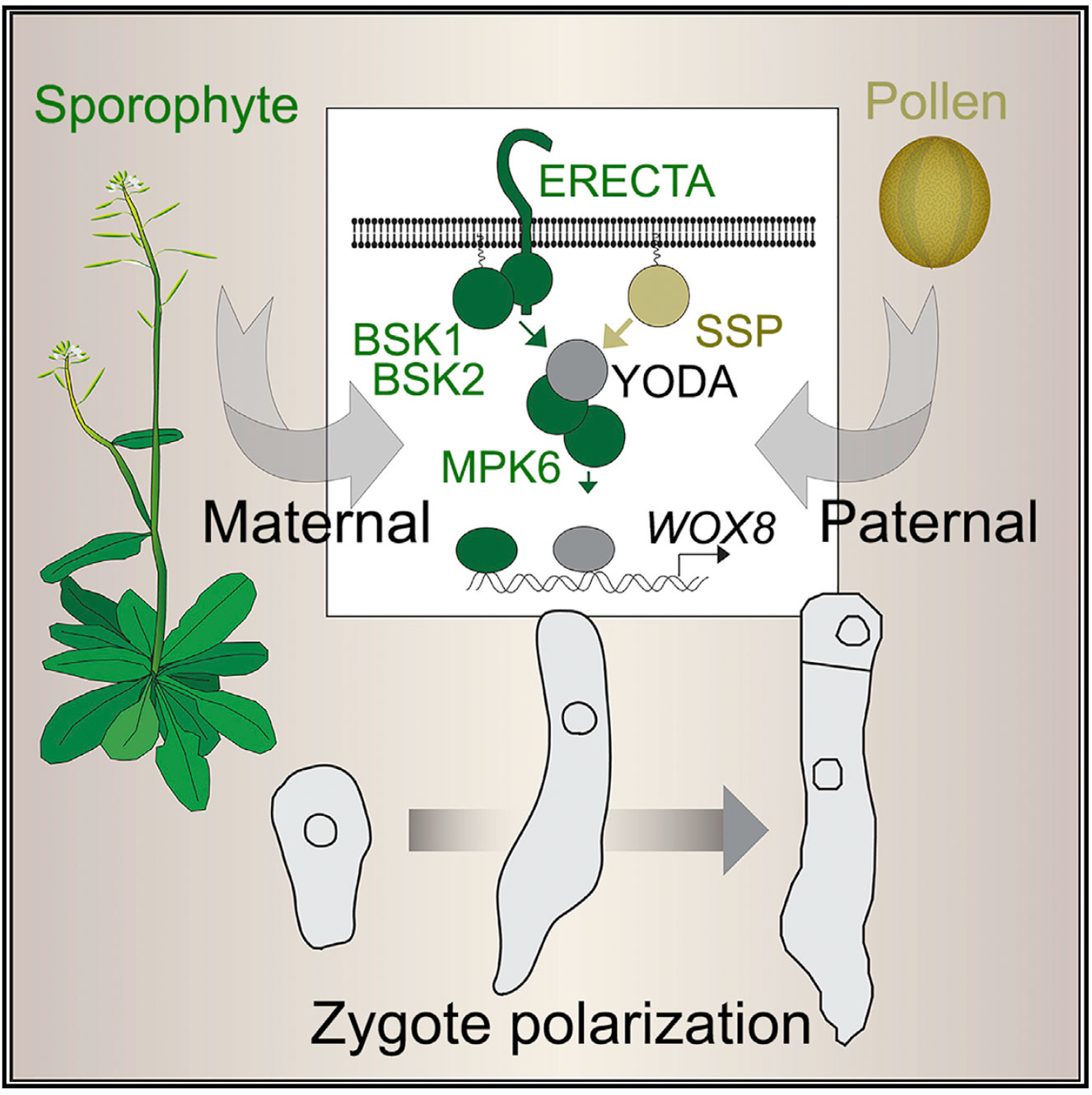博文
Current Biology:拟南芥中亲本双方的独立贡献作用于合子极化的起始
||
Independent parental contributions initiate zygote polarization in Arabidopsis thaliana
第一作者:Kai Wang
第一单位:马克斯·普朗克发育生物学研究所
第一通讯:Martin Bayer
Abstract
背景回顾:Embryogenesis of flowering plants is initiated by polarization of the zygote, a prerequisite for correct axis formation in the embryo. The daughter cells of the asymmetric zygote division form the pro-embryo and the mostly extra-embryonic suspensor. The suspensor plays a pivotal role in nutrient and hormone transport and rapid growth of the embryo. Zygote polarization is controlled by a MITOGEN-ACTIVATING PROTEIN (MAP) kinase signaling pathway including the MAPKK kinase (MAP3K) YODA (YDA) and the upstream membrane-associated proteins BRASINOSTEROID SIGNALING KINASE 1 (BSK1) and BSK2. Furthermore, suspensor development is controlled by cysteine-rich peptides of the EMBRYO SURROUNDING FACTOR 1 (ESF1) family. While they act genetically upstream of YDA, the corresponding receptor to perceive these potential ligands is unknown. In other developmental processes, such as stomata development, YDA activity is controlled by receptor kinases of the ERECTA family (ERf). While the receptor kinases upstream of BSK1/2 in the embryo have so far not been identified, YDA is in part activated by the sperm cell-derived BSK family member SHORT SUSPENSOR (SSP) that represents a naturally occurring, constitutively active variant of BSK1. It has been speculated that SSP might be a paternalcomponent of a parental tug-of-war controlling resource allocation toward the embryo.
主要发现:Here, we show that in addition to SSP, the receptor kinase ERECTA plays a crucial role in zygote polarization as a maternally contributed part of the embryonic YDA pathway.
结论:We conclude that two independent parental contributions initiate zygote polarization and control embryo development.

摘 要
有花植物的胚胎发生起始于合子的极性化,该过程是胚胎轴正确建立的先决条件。合子不对称分裂的子细胞形成了原胚和大多数的胚外胚柄。胚柄在营养和激素运输以及胚胎的快速生长方面发挥着重要作用。合子的极性化受到MAP激酶信号转导通路控制,该通路包括MAPKK激酶YDA和上游的膜相关蛋白BSK1和BSK2。此外,胚柄的发育受到ESF1家族的控制。虽然这些基因作用于YDA的上游,但是能够感知这些潜在配体的受体还不清楚。在气孔发育等其它的一些发育进程中,YDA的活性受到ERECTA家族受体激酶的控制。胚胎中BSK1/2的受体激酶还未能被鉴定到,但是YDA部分受到了来自精子的BSK家族SSP蛋白的激活,SSP蛋白是一种BSK1的组成型激活变体。有研究推测,SSP可能是亲本“拉锯战”中的来自父本的部分,由此控制胚胎的资源分配。本文中,作者发现除了SSP之外,受体激酶ERETA在合子极性化中起着关键作用,是胚胎YDA途径中由母本贡献的部分。作者认为两个来自亲本双方、相互独立的部分共同起始了合子的极性化,从而控制着胚胎的发育。
通讯作者
** Martin Bayer **
个人简介:
2000年,霍恩海姆大学,博士;
2004年,冷泉港实验室,博后;
2008年,苏黎世大学,博后。
研究方向:拟南芥中源自精子的信号指导早期的胚胎发生。
doi: https://doi.org/10.1016/j.cub.2021.08.033
Journal: Current Biology
Published date: September 07, 2021
https://blog.sciencenet.cn/blog-3158122-1303460.html
上一篇:Nature Plants:单细胞转录动态的实时监控——以磷酸盐响应基因为例
下一篇:Nature Plants:氧化还原依赖性的CBF结构转变和激活赋予植株低温抗性
全部作者的其他最新博文
- • Plant Physiology:CsMADS3促进柑果中的叶绿素降解和类胡萝卜素合成(华中农业大学)
- • Molecular Plant:LBD11-ROS反馈调节作用于拟南芥的维管形成层增殖和次生生长(浦项科技大学)
- • Science Advances:根结线虫通过调控植物的CLE3-CLV1模块,促进侵染进程(日本熊本大学)
- • Nature Communications:油菜素内酯参与植物营养生长期转变的分子机制解析(浙江农林大学)
- • Current Biology:光合作用产生的蔗糖驱动侧根“生物钟”(德国弗莱堡大学)
- • PNAS:花同源异型基因在叶中被抑制、花中被激活的分子机制(南卡罗来纳大学)